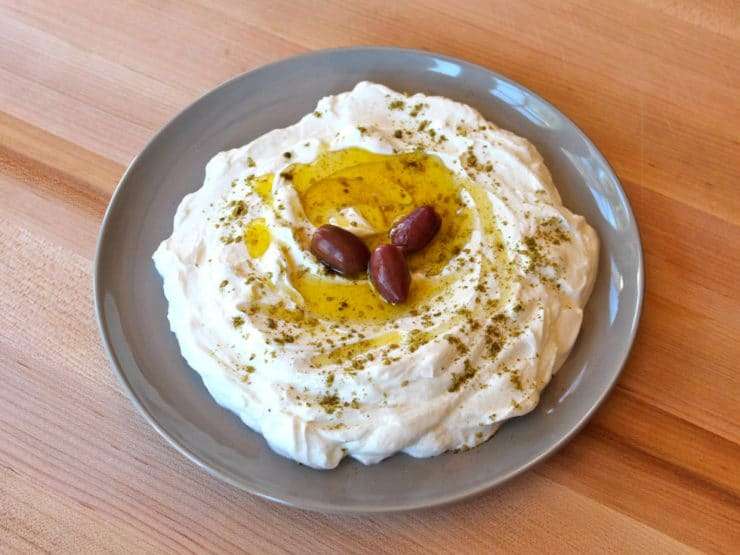
4.9 from 57 votes
How to Strain Yogurt
Learn the step by step process of straining yogurt, an ancient technique that produces thick, rich, healthy Greek yogurt and labneh cheese.
Prep Time
5 mins
Cook Time
1 d 4 hrs 5 mins
Total Time
1 d 4 hrs 52 mins
Servings: 1 serving, or more
Calories: 298 kcal
Course:
Side Dish
Cuisine:
Middle Eastern
Ingredients
- 2 cups plain yogurt - any fat content , more or less as needed
- 1/8 teaspoon salt , optional, or to taste - for labneh
Instructions
- Assemble the tools. Place your colander over your bowl.
- Cut the cheesecloth into 18-inch rectangles to form 6 to 8 layers of cloth. Line colander with the cheesecloth.
- Scoop yogurt into the middle of the cheesecloth.
- Gather up the sides of the cheesecloth to form a bundle, and tie it at the top with the twine or string. Do not squeeze the bundle, just let it rest inside the colander. The bowl below will catch the excess liquid.
- If using muslin or a thin dish towel, line the colander with one layer of cloth and proceed with filling with yogurt and tying, just as you would with cheesecloth. Any thin, tightly knit fabric will work. I've even heard of people using a very clean pillowcase to line the colander. Don't use a thick kitchen towel, it will absorb too much of the yogurt during the straining process.
- If using a coffee filter, line the colander with the filter. You want the base of the colander covered with a single layer of filter. Depending on what type of filter you use, the size of your colander, and/or how much yogurt you want to strain, you may need more than one filter to achieve this.
- Place the yogurt in the middle of the filter(s). Cover the yogurt surface with plastic wrap (plastic touching the yogurt).
- Place the colander, bowl, and yogurt inside the refrigerator and let the excess liquid strain into the bowl through the colander. Check after 1 hour to make sure the liquid that is dripping into the bowl is thin and not too white. It should be slightly milky, with no chunks of white in it. If the liquid has a lot of white stuff in it, your cheesecloth is not thick enough, which means you’re losing yogurt instead of liquid. Wrap a few more layers of cheesecloth around the bundle. If the liquid is clear, you're good to go.
- The longer you strain the yogurt, the thicker it will be. To make plain yogurt into Greek yogurt, strain overnight (10-12 hours) to 48 hours. Check consistency every 12 hours and stop straining when you reach the consistency you like.
- To make plain yogurt into rich, thick labneh cheese* (aka yogurt cheese), let is strain for 48-72 hours. Stir in salt as desired; a little salt really brings out the "cheese" flavor. Try 1/8 tsp for 2 cups of yogurt, adjust to taste. You can also strain kefir in the same way you strain yogurt; it will take a bit longer to thicken than yogurt because it has a higher liquid content. You can even strain Greek yogurt to thicken it and make the flavor more potent (I do this when I make tzatziki sauce).
- *Note: I use the term “cheese” here loosely. Strained yogurt does not actually produce cheese in the traditional sense of the word; labneh (aka yogurt cheese) is simply a thickened form of yogurt.
Cup of Yum
Notes
- You will also need: cheesecloth, muslin, a thin dish towel, or a coffee filter; colander or strainer; medium bowl to rest strainer in; kitchen twine or string.
Nutrition Information
Calories
298kcal
(15%)
Carbohydrates
22g
(7%)
Protein
17g
(34%)
Fat
15g
(23%)
Saturated Fat
10g
(50%)
Cholesterol
63mg
(21%)
Sodium
225mg
(9%)
Potassium
759mg
(22%)
Sugar
22g
(44%)
Vitamin A
485IU
(10%)
Vitamin C
2.5mg
(3%)
Calcium
593mg
(59%)
Iron
0.3mg
(2%)
Nutrition Facts
Serving: 1serving, or more
Amount Per Serving
Calories 298
% Daily Value*
| Calories | 298kcal | 15% |
| Carbohydrates | 22g | 7% |
| Protein | 17g | 34% |
| Fat | 15g | 23% |
| Saturated Fat | 10g | 50% |
| Cholesterol | 63mg | 21% |
| Sodium | 225mg | 9% |
| Potassium | 759mg | 16% |
| Sugar | 22g | 44% |
| Vitamin A | 485IU | 10% |
| Vitamin C | 2.5mg | 3% |
| Calcium | 593mg | 59% |
| Iron | 0.3mg | 2% |
* Percent Daily Values are based on a 2,000 calorie diet.